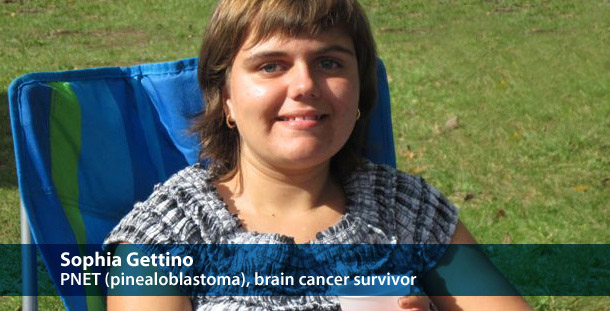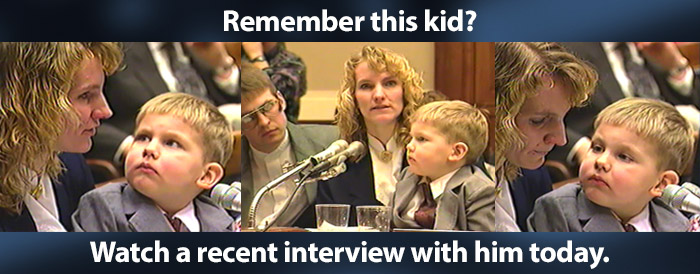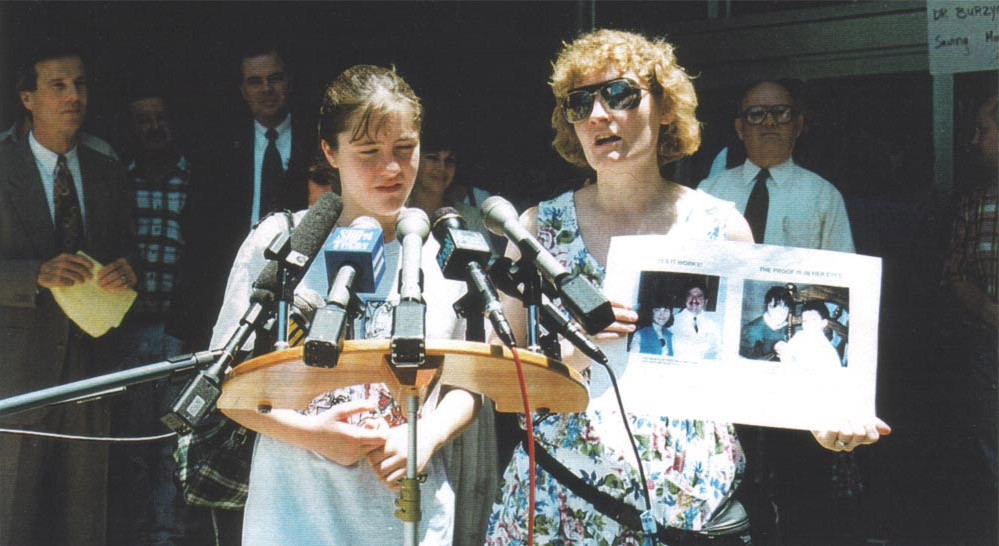
Sophia Gettino was diagnosed with a pinealoblastoma brain tumor on December 18, 1996—when she was 10 months old. [1]
Sophia was born in January 1996. In December of 1996, Sophia’s parents noticed that she was having trouble with her motor skills, displaying a decrease in appetite, and had noticeable swelling of the head.
After several visits to the pediatrician’s office, they decided to have an MRI conducted to see if anything was wrong with her brain. The MRI revealed a mass measuring nearly 3 cm in her brain. On December 18, 1996 a biopsy was performed by the pathology department at the Syracuse Health Center in Syracuse, New York—which diagnosed Sophia with a deadly pinealoblastoma brain tumor.
On December 20, 1996 surgeons at the Syracuse Health Center removed nearly all of her tumor, but were unable to remove it all without injuring Sophia any further.
In their evaluation report oncologists at Syracuse stated “Because of her age, short onset of symptoms and pathologic findings, her prognosis unfortunately is very poor. The option of chemotherapy was presented to the family.”
The chemotherapy offered to Sophia was a combination of thiotepa, etoposide, and carboplatine.
Thiotepa Chemotherapy was approved by the FDA on March 9, 1959. This drug was approved for breast, ovary, and bladder cancer primarily. To date, thiotepa’s “safety and effectiveness in pediatric patients have not been established.” The expected side effects of this chemotherapy in non-pediatric patients are: low blood cell count, vomiting, infertility, hair loss, blurred vision, and being a carcinogen causes more cancer.
Etoposide Chemotherapy was approved by the FDA on November 11, 1983. This drug is used to treat people with testicular cancer or small cell lung cancer. In pediatric patients, etoposide’s “safety and efficacy have not been established”. The side effects in non-pediatric patients receiving this therapy include leukemia, nerve damage, inability to fight infections, and vomiting. There is limited evidence to verify whether or not this drug used alone causes more cancer, but there is sufficient evidence that when used with other chemotherapy that is does cause cancer.
Carboplatine Chemotherapy was approved in the late 1980’s and is primarily used to treat ovarian, lung, and head and neck cancers. “the most troubling effects of carboplatin tends to be damage to the bone marrow…” Other side effects include damage to the nervous system, mouth sores, loss of appetite, stomach pain, diarrhea, vomiting, and changes in vision.
After understanding that these chemotherapeutic drugs would not likely save Sophia, combined with the side effects this chemotherapy regimen could cause to their daughter, Sophia’s parents declined all chemotherapy treatment offered by their oncologists and decided to explore other methods of treatment. Upon this search for another option they found the Burzynski Clinic.
On February 27, 1997 Sophia was admitted for antineoplaston therapy in a FDA-supervised Phase II clinical trial. She discontinued antineoplaston therapy on March 7, 2003 due to a complete response. She is alive, healthy, and remains cancer-free today. (A residual, benign tumor is still left in her brain, but all signs of malignancy have disappeared and have not returned to date).
Medical Records
Diagnosis:
1. December 18, 1996 pathology report from Syracuse Health Center.
2. December 25, 1996 Syracuse Health oncology evaluation report verifying diagnosis, with suggested experimental chemotherapy regimen.
Baseline MRI of the brain on February 26, 1997 showing a massive tumor in her brain.
Recovery:
4. Sophia’s Phase II FDA-clinical trial treatment summary
5. Tumor Measurements from start of treatment to declaration of “complete response”.
6. A third party confirmation of complete response from J.C. Pleasure, MD of Oncoimaging, P.A. in Herdon, VA
7. February 3, 2003 MRI scan showing the residual benign remnants of the once malignant tumor.
Comparing the FDA clinical trial data for this type of tumor
In a group of Phase II clinical trials using only Antineoplastons, with 13 children ranging from one to eleven years old with PNET tumors: Six of those patients (46%) survived more than 5 years after treatment. Five of the six patients had not undergone any previous chemotherapy or radiation prior to being treated with Antineoplastons. Click here to read this study’s abstract.
In contrast, a chemotherapy drug produced by GlaxoSmithKline called Topotecan (also a gene-targeted drug), is undergoing Phase II trials for this type of tumor in children as well. Twenty-six children were treated, two objective responses were noted (7.6%), and these two patients managed to live beyond five years. However, this does not indicate the damage, if any, this chemotherapeutic drug caused these patients. Click here to read this study.
Therefore, in virtually identical Phase II gene-targeted clinical trials treating PNET in children: topotecan chemotherapy resulted in a 7.6% 5-year survival; while Antineoplastons resulted a 46% 5-year survival. It’s important to note that while Antineoplastons are free of harmful side effects, topotecan’s side effects generally include: hair loss, vomiting, and diarrhea—if you are lucky. If you are one that has a more severe reaction to this drug, the side effects can include: difficulty breathing; swelling of the face, lips and tongue; severe cough; painful urination, unexplained bruising, and stomach cramps. Click here more on this drug.
Sophia Gettino’s medical records are published by written authorization by her family.




You must be logged in to post a comment.